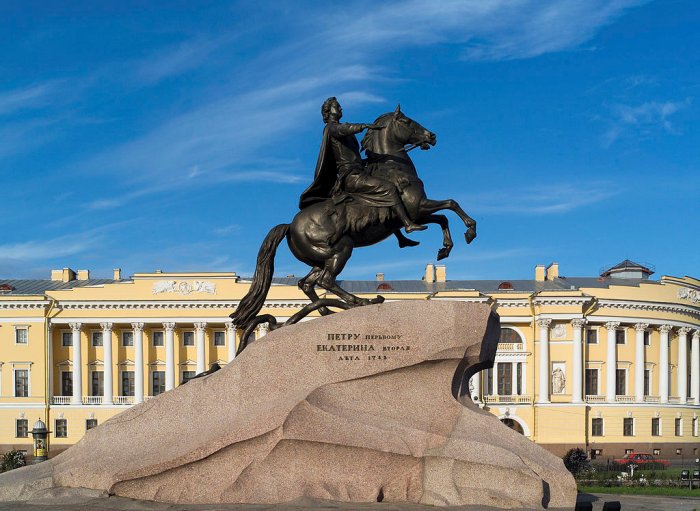The Thunder Stone: World’s Largest Monolith Moved By Man
Jan Bartek - AncientPages.com - The Thunder Stone is the world’s largest monolith ever to be moved by man. It gained its name from an ancient local legend that thunder split a piece of the stone.
The monolith was discovered at Lakhta, 6 km (3.7 mi) inland from the Gulf of Finland in 1768.
The stone was moved from Finland to St. Petersburg, Russia, to serve as a pedestal for the Bronze Horseman, the equestrian statue of Peter the Great.

The Transportation of the Thunder-stone in the Presence of Catherine II; Engraving by I. F. Schley of the drawing by Yury Felten, 1770
Catherine the Great, a German princess who married into the Romanov line, wished to connect herself to Peter the Great to gain legitimacy in the eyes of the people. She ordered, therefore, ordered the construction of the Bronze Horseman. It was her way of showing her admiration for her predecessor and her view of her own place in the line of great Russian rulers.
Today, the statue is one of the symbols of Saint Petersburg, in much the same way that the Statue of Liberty is a symbol of New York City.
It is said that the Thunder Stone was moved by manpower, rollers, and capstans. Later it was transported by barge up the Neva River to St. Petersburg. Moving the stone required 400 men and took nine months, during which time master stonecutters continuously shaped the enormous granite monolith.

The Bronze Horseman statue of Peter the Great. Credit: Godot13 - CC BY-SA 3.0
The workers made over 150 m of progress a day while on level ground. Upon arrival at the sea, an enormous barge was constructed exclusively for the Thunder Stone. The vessel had to be supported on either side by two full-size warships.
After a short voyage, the stone reached its destination in 1770 after nearly two years of work. A medal was issued to commemorate its arrival, with the legend "Close to Daring". The stone's dimensions before being cut were 7 × 14 × 9 m. Based on the density of granite, its weight was determined to be around 1500 tons.
The entire effort is considered a historic feat of engineering!
Written by Jan Bartek - AncientPages.com Staff
Expand for referencesReferences:
Wikipedia
More From Ancient Pages
-
 On This Day In History: Battle of Englefield Was Fought – On Dec 31, 870
News | Dec 31, 2016
On This Day In History: Battle of Englefield Was Fought – On Dec 31, 870
News | Dec 31, 2016 -
 Grave Creek Mound – One Of North America’s Most Curious Ancient Monuments
Featured Stories | Aug 8, 2024
Grave Creek Mound – One Of North America’s Most Curious Ancient Monuments
Featured Stories | Aug 8, 2024 -
 Dragon’s Head – One Of The Most Famous Viking Symbols Discovered At Birka Ancient Excavation Site
Ancient Symbols | May 19, 2015
Dragon’s Head – One Of The Most Famous Viking Symbols Discovered At Birka Ancient Excavation Site
Ancient Symbols | May 19, 2015 -
 Strange Community Rules Of Essenes Preserved In The Dead Sea Scrolls
Ancient History Facts | Jun 9, 2020
Strange Community Rules Of Essenes Preserved In The Dead Sea Scrolls
Ancient History Facts | Jun 9, 2020 -
 3.2 Million-Year-Old ‘Lucy’ Could Walk On Two Legs – First Hominin Muscle Reconstruction
Archaeology | Jun 20, 2023
3.2 Million-Year-Old ‘Lucy’ Could Walk On Two Legs – First Hominin Muscle Reconstruction
Archaeology | Jun 20, 2023 -
 Unusual Discovery Of A Viking Age Phallic Stone In Tystberga, Sweden
Archaeology | Jun 12, 2023
Unusual Discovery Of A Viking Age Phallic Stone In Tystberga, Sweden
Archaeology | Jun 12, 2023 -
 First Evidence Common People Drank Wine In Troy (Not Just The Elites)
Archaeology | Mar 31, 2025
First Evidence Common People Drank Wine In Troy (Not Just The Elites)
Archaeology | Mar 31, 2025 -
 Sobek – Enigmatic Crocodile God Of Ancient Egypt
Civilizations | Sep 5, 2015
Sobek – Enigmatic Crocodile God Of Ancient Egypt
Civilizations | Sep 5, 2015 -
 Humans’ Evolutionary Relatives Butchered One Another 1.45 Million Years Ago
Ancient Symbols | Jun 26, 2023
Humans’ Evolutionary Relatives Butchered One Another 1.45 Million Years Ago
Ancient Symbols | Jun 26, 2023 -
 On This Day In History: Columbus Reached Honduras With His Ships – On July 30, 1502
News | Jul 30, 2016
On This Day In History: Columbus Reached Honduras With His Ships – On July 30, 1502
News | Jul 30, 2016 -
 On This Day In History: King Alexander II Was Crowned At Scone, Scotland – On Dec 6, 1214
News | Dec 6, 2016
On This Day In History: King Alexander II Was Crowned At Scone, Scotland – On Dec 6, 1214
News | Dec 6, 2016 -
 DNA Study Sheds New Light On Ancient Britain’s Language, Ancestry, Kinship, Milk
Archaeology | Dec 26, 2021
DNA Study Sheds New Light On Ancient Britain’s Language, Ancestry, Kinship, Milk
Archaeology | Dec 26, 2021 -
 Lamplighters In London: An Important Job In The Victorian Era
Ancient History Facts | May 17, 2019
Lamplighters In London: An Important Job In The Victorian Era
Ancient History Facts | May 17, 2019 -
 Violent Conflict Played A Crucial Role In Early Farming Societies In Neolithic Europe – New Study
Archaeology | Jun 19, 2023
Violent Conflict Played A Crucial Role In Early Farming Societies In Neolithic Europe – New Study
Archaeology | Jun 19, 2023 -
 Ancient Europeans Ate Seaweed And Freshwater Plants – Evidence Found
Archaeology | Oct 17, 2023
Ancient Europeans Ate Seaweed And Freshwater Plants – Evidence Found
Archaeology | Oct 17, 2023 -
 Bhimbetka: Gigantic Open Air Repository Of Prehistoric Art In India
Featured Stories | Jun 11, 2016
Bhimbetka: Gigantic Open Air Repository Of Prehistoric Art In India
Featured Stories | Jun 11, 2016 -
 Sed Festival – Ancient Egyptian Ritual Tested Pharaohs
Ancient History Facts | Mar 28, 2018
Sed Festival – Ancient Egyptian Ritual Tested Pharaohs
Ancient History Facts | Mar 28, 2018 -
 15,000-Year-Old Petroglyphs Discovered In The Gobi Desert May Be Evidence Ancient Turks Visited Mongolia – Expert Says
Archaeology | Apr 5, 2022
15,000-Year-Old Petroglyphs Discovered In The Gobi Desert May Be Evidence Ancient Turks Visited Mongolia – Expert Says
Archaeology | Apr 5, 2022 -
 Owain Glyndwr: Famous Medieval Welsh Warrior Prince And Symbol Of Independence
Featured Stories | Jun 20, 2018
Owain Glyndwr: Famous Medieval Welsh Warrior Prince And Symbol Of Independence
Featured Stories | Jun 20, 2018 -
 What Is The Curse Of The Ninth Symphony?
Ancient History Facts | Aug 3, 2018
What Is The Curse Of The Ninth Symphony?
Ancient History Facts | Aug 3, 2018
